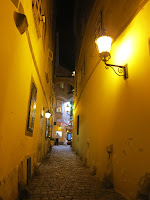This hotel, Hotel Post, had to be the easiest place to find
– thanks to a very helpful young man at the tourist information office at
Vienna Hauptbahnhof. ‘Down three levels and catch the U1 line four stops to
Schwedenplatz. My colleague can sell you the tickets!’ Easy – and even finding
our way to the hotel was easy - given we
only had to walk about 200m, but because it was so close we missed a turn –
thanks Google!
 |
| St Stephen's Altar |
 |
| St Stephen's Cathedral |
Our first day [we actually arrived early as the train we
just managed to catch at Bratislava was an hour earlier than the one we had had
reserved for us – but because our tickets were ‘open’ we could catch any train]
we arrived at 11.30 – check in didn’t start until 2.00 pm but the hotel manager
was there at the time and she did two wonderful things: (1) gave us an upgraded
room from our shared bathroom we had paid for to a business suite with private
bathroom – luxury at NO extra cost even though we offered!; and (2) allowed us
to check in early because our ‘new’ room was ready. Hotel Post – this a great
advertisement of your service. So effectively, we had an extra half-day here.
Our first day we basically spent doing a self – guided
walking tour, broken in the middle to go to mid-day Mass. More walking; a cheap
supermarket lunch €4.85 – which meant 4 bananas; two fresh bread buns; two
nectarines and a bottle of coke – enough to get us through to an early dinner
and a walk through the streets of old town Vienna arguing about where to eat.
First World problem – and the thousands of refugees are just a few km down the
road!
Holy Trinity Column from 1679 and Karlsplaz Metro Station
The refugee problem has become a major headache for Austria
but it has still continued to take in refugees albeit with restrictions. Those
who ‘made it’ have been accommodated in all sorts of places – many on the green
spaces at each end of West Bahnhof; some have even been taken into the homes of
people of Vienna who have opened up to try to help with what is clearly a major
problem for Europe. Germany received 10,000 refugees in one day last week. How
do countries deal with issues of this magnitude?
Schonbrunn - Gloriette and Palace
However, as tourists, we have been impressed with Vienna.
Five days here and we have used every one. We took out a three day travel pass
[for €16.50 pp] and used it to within 5 minutes of its expiry. We have done a
lot of travel on trams and trains [buses were included but we didn’t use any]
and very easily made the most of our outlay.
Twice we went to Schӧnbrunn: one day to the zoo where
[amongst other ‘normal’ zoo animals] we came face to face with a surfacing
polar bear in relax mode; an arctic wolf which was a part of a zoo breeding
programme; and even a black jaguar: seems most of the animals were struggling
in the 33⁰C heat as much as we were. Still the early autumn days here have been
glorious. Great for the tourism industry.
Schonbrunn Zoo - Arctic Wolf, Red Squirrel and Meerkat
 |
| Surfacing Polar Bear, Vienna Zoo |
could see all the facial movements – the smiles, the grimaces – and the finger movements but at the same time it felt as though we were a bit like the two old grizzling geezers from the muppets. However, no grizzles – great night of Viennese culture!
Mozart Concert (period costume) in Wiener Musikverein
We have also managed to fit in a half hour or so with the
locals at Vienna’s Danube ‘beach’ on the little Danube across the river from
downtown Vienna. However, not really tempted to swim or even dip toes into the
water… it was nice to have the feel of grass under the feet for a change. There
are places here [like Schönbrunn] where signs have been erected specifically
asking for people to stay off the grass. Got to keep up the good looks.
We have also enjoyed the location of the hotel – 5 minutes
from the main shopping street – and 10 minutes from Stephensplatz; and about
another 10 minutes from most other places. All this, of course, made the
walking tours more easily accessible. But we still managed to clock up on
average 12km/day while in Vienna.
Hundertwasser's Krawina House adds vibrancy to Vienna
And so, while we haven’t really ‘done Vienna’ we have given
it a good shot; so friendly; so easy to get around with the amount of English
spoken; signage is English friendly; train stations are among the best we have
seen in Europe as to their layout which, with the signage, made getting around
here, much easier than in other countries we have visited to date. But tomorrow
morning it ends [in Vienna, that is] and we fly out to Zurich which we imagine
will do major damage to the pocket. Just as well we have been able to travel a
bit under budget to date!
The oldest street in Fleischmarkt The new city across the Danube

























































